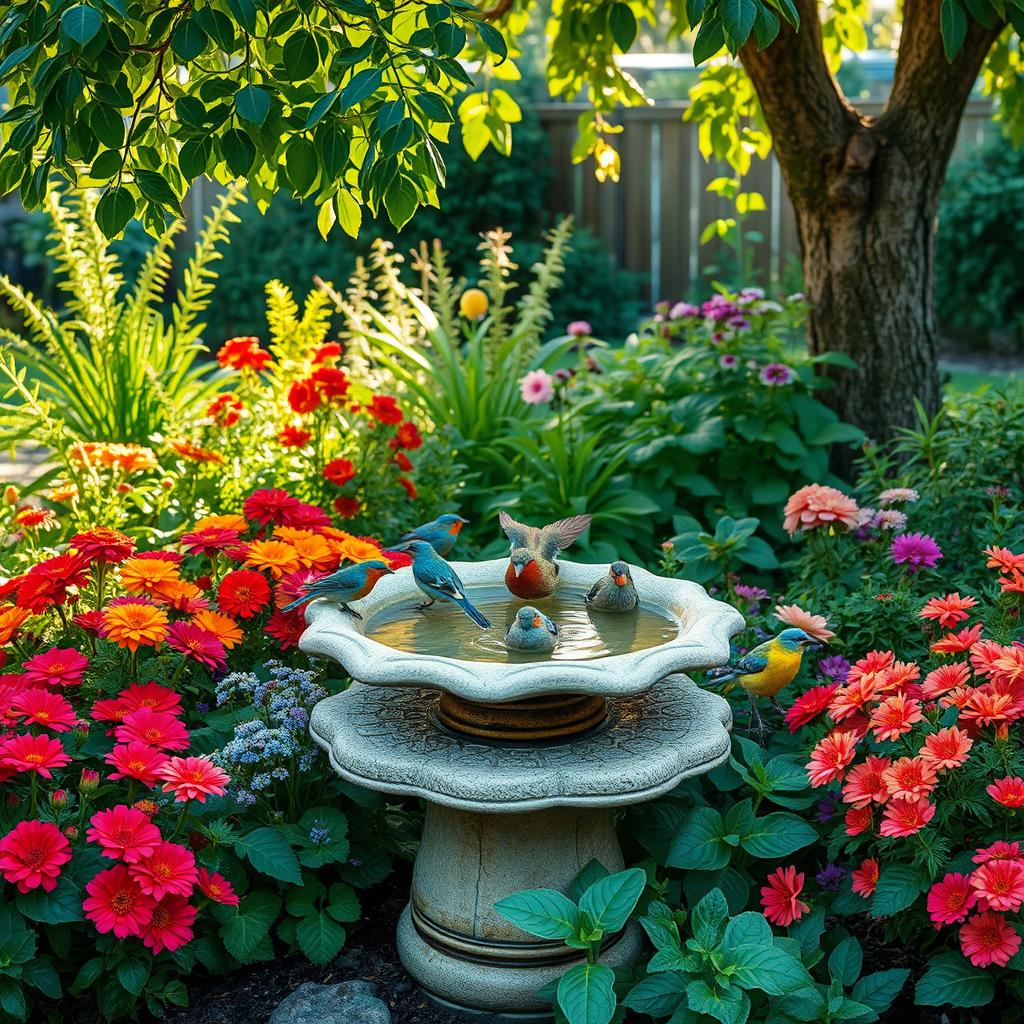Table of Contents
- Understanding the Essential Elements of a Perfect Bird Bath
- Creating Your DIY Garden Bird Bath on a Budget
- Smart Placement Strategies for Maximum Bird Attraction
- Solar-Powered Fountain Features for Enhanced Appeal
- Winter-Ready Bird Bath Solutions
- Natural and Eco-Friendly Bird Bath Designs
- Essential Maintenance and Cleaning Protocols
- Creative Landscaping Around Your Bird Bath
- Troubleshooting Common Bird Bath Problems
- Advanced Features for Your Bird Bath
- Safety Considerations for Backyard Birds
- Conclusion
- FAQ
Ever thought about turning your backyard into a bird paradise? A garden bird bath could be the answer you’ve been looking for!
Building the perfect bird bath is more than just a water container. It’s about creating a welcoming spot for birds. This spot is crucial for them to find water during hot summers and tough seasons.
If you love birds or just want to attract them, this guide is for you. It will show you how to make a bird bath that makes your yard a wildlife sanctuary.
Key Takeaways
- Understand essential bird-bath design principles
- Learn budget-friendly DIY techniques
- Discover optimal placement strategies
- Master maintenance and cleaning protocols
- Create a safe water environment for backyard birds
Understanding the Essential Elements of a Perfect Bird Bath
To attract birds, you need to think about a few key things. A good bird bath can turn your backyard into a haven for wildlife. It invites birds to come and cool off.
Not all bird baths are the same. The right one can really help attract birds to your area.
Water Depth Requirements for Different Bird Species
Each bird likes its water depth differently. Here’s a quick guide to help you understand their needs:
- Small songbirds: Prefer shallow water (1-2 inches deep)
- Medium-sized birds: Enjoy depths of 2-3 inches
- Larger birds like robins: Can handle 3-4 inches of water
Optimal Materials for Long-lasting Bird Baths
“Choose materials that withstand the elements while providing a safe, comfortable space for birds.”
When picking materials for bird baths, go for these durable ones:
- Ceramic: Beautiful but can crack in extreme temperatures
- Concrete: Sturdy and weather-resistant
- Metal: Durable with proper coating to prevent rusting
- Recycled plastic: Eco-friendly and lightweight
Size and Shape Considerations
The best bird bath is both functional and pretty. Look for designs that offer:
- Stable base to prevent tipping
- Textured surfaces for bird grip
- Wide, shallow basins for easy access
- Gentle slopes for different bird sizes
Creating Your DIY Garden Bird Bath on a Budget
Making your own bird bath is easy and doesn’t cost much. You can turn simple items into beautiful spots for birds in your backyard.
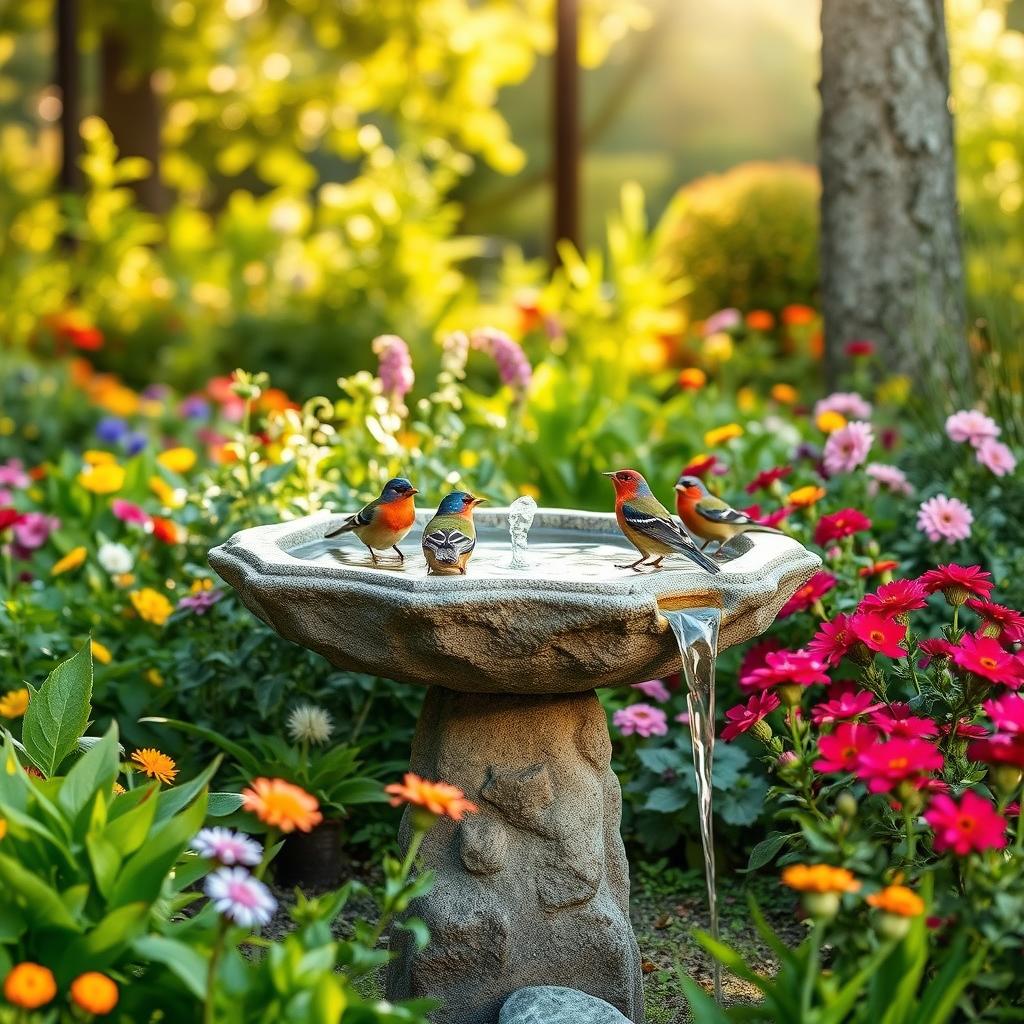
Starting a bird bath project is simple and fun. Look around your home or garden for materials you already have.
- Ceramic plant saucers
- Recycled shallow dishes
- Old baking pans
- Terracotta pot bases
“Creativity is the key to designing an affordable bird bath that attracts wildlife to your garden.” – Wildlife Conservation Expert
Choose materials that are stable and hold water well. Make sure the base is strong and the surface is safe for birds.
| Material | Cost | Difficulty Level |
|---|---|---|
| Ceramic Dish | $5-$10 | Easy |
| Concrete Basin | $15-$25 | Moderate |
| Recycled Pottery | $0-$5 | Very Easy |
Pro tip: Use waterproof sealant on porous materials to extend the life of your diy bird bath ideas. This simple step prevents cracking and maintains water quality for your winged visitors.
- Clean materials thoroughly before use
- Place in a partially shaded area
- Maintain shallow water depth (1-2 inches)
Remember, the best bird bath is one that fits your garden’s unique style and budget.
Smart Placement Strategies for Maximum Bird Attraction
Creating the perfect bird bath spot in your garden needs careful planning. Birds look for safe, comfy, and easy-to-reach places to bathe and drink.
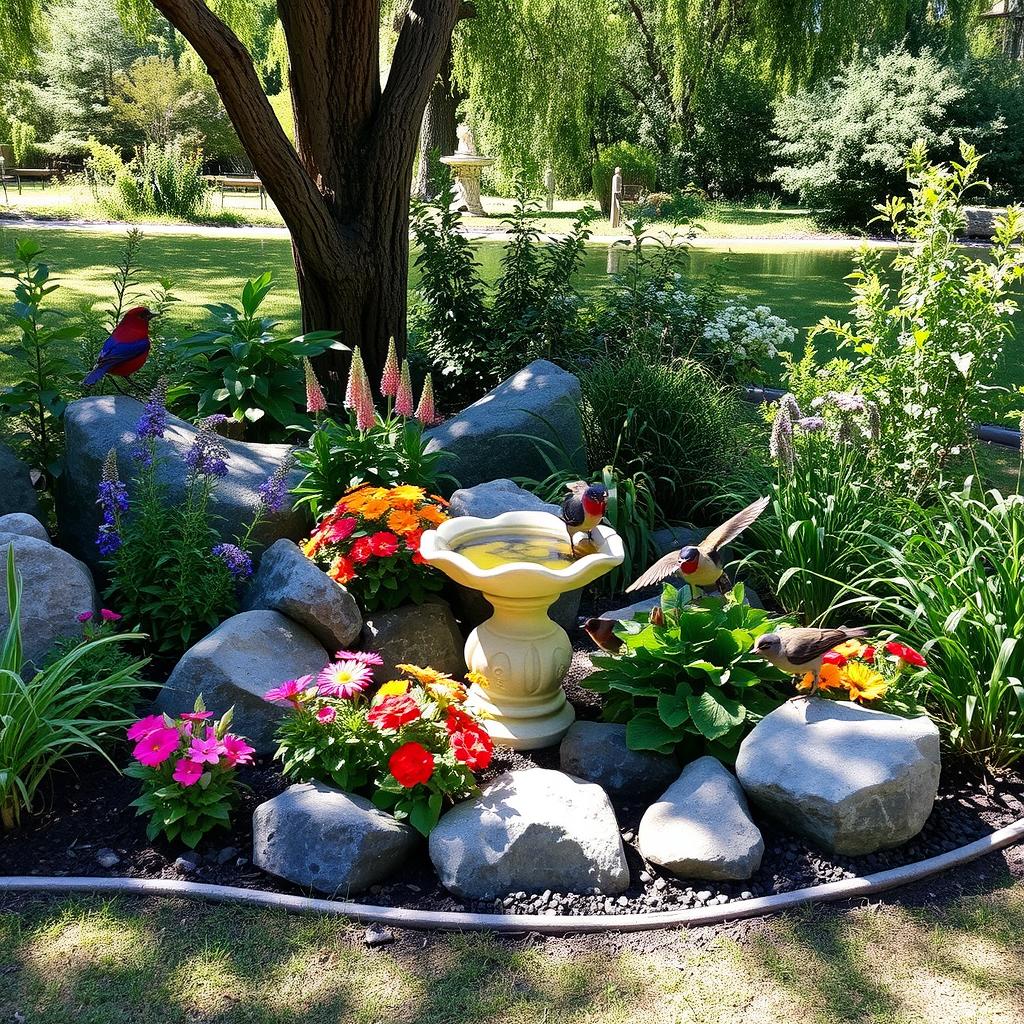
Understanding what birds need is key to placing your bird bath right. The right spot can turn your garden into a lively wildlife haven.
Distance from Natural Cover and Feeders
Think about how close your bird bath is to natural hiding spots. Birds want to be able to quickly hide from predators. Place your bath:
- Within 10-15 feet of shrubs or trees
- Near existing bird feeders
- In a spot where you can see it clearly
“A well-placed bird bath is like a welcome mat for wildlife” – Wildlife Gardening Expert
Sun vs. Shade Positioning
Choosing the right spot for your bird bath is about sun and shade. Each time of day has its own benefits:
- Morning Sun: Wakes up the birds and keeps them warm
- Afternoon Shade: Keeps the water cool and stops it from evaporating too fast
Protection from Predators
Keeping your bird bath safe is important for the birds’ safety. Here are some tips:
- Elevate the bath 3-4 feet above the ground
- Put up perches nearby for birds to watch out
- Don’t have too much dense ground around that could hide predators
By using these smart placement tips, you’ll make a welcoming spot for birds to visit and enjoy.
Solar-Powered Fountain Features for Enhanced Appeal
Bird lovers are finding joy in solar-powered bird bath fountains. These fountains turn simple backyards into lively spots for wildlife. They add movement and life to bird baths, drawing in birds from far and wide.

Solar-powered bird bath fountains do more than look good. They move water, which naturally draws birds. This movement signals to birds that there’s a good spot to visit. These fountains have many benefits:
- Continuous water circulation prevents stagnation
- Reduces mosquito breeding potential
- Keeps water fresh and clean
- Environmentally friendly power source
When picking solar-powered bird bath fountains, think about a few important things:
- Battery storage capacity
- Solar panel efficiency
- Water pump performance
- Weather resistance
“A moving water feature transforms your bird bath from a simple water container to a dynamic wildlife attraction.” – Wildlife Conservation Expert
Setting up solar-powered bird bath fountains is easy. Most need little setup, with solar panels placed for best sun exposure. You’ll only need to clean the panels and check the water now and then.
By using solar power in bird bath designs, backyard bird fans can make eco-friendly, engaging spots. These spots help local wildlife and are good for the planet.
Winter-Ready Bird Bath Solutions
Keeping birds hydrated in the cold is a big challenge for bird watchers. Heated bird baths are key to helping our feathered friends when water freezes. These baths make sure birds can drink even when it’s very cold.
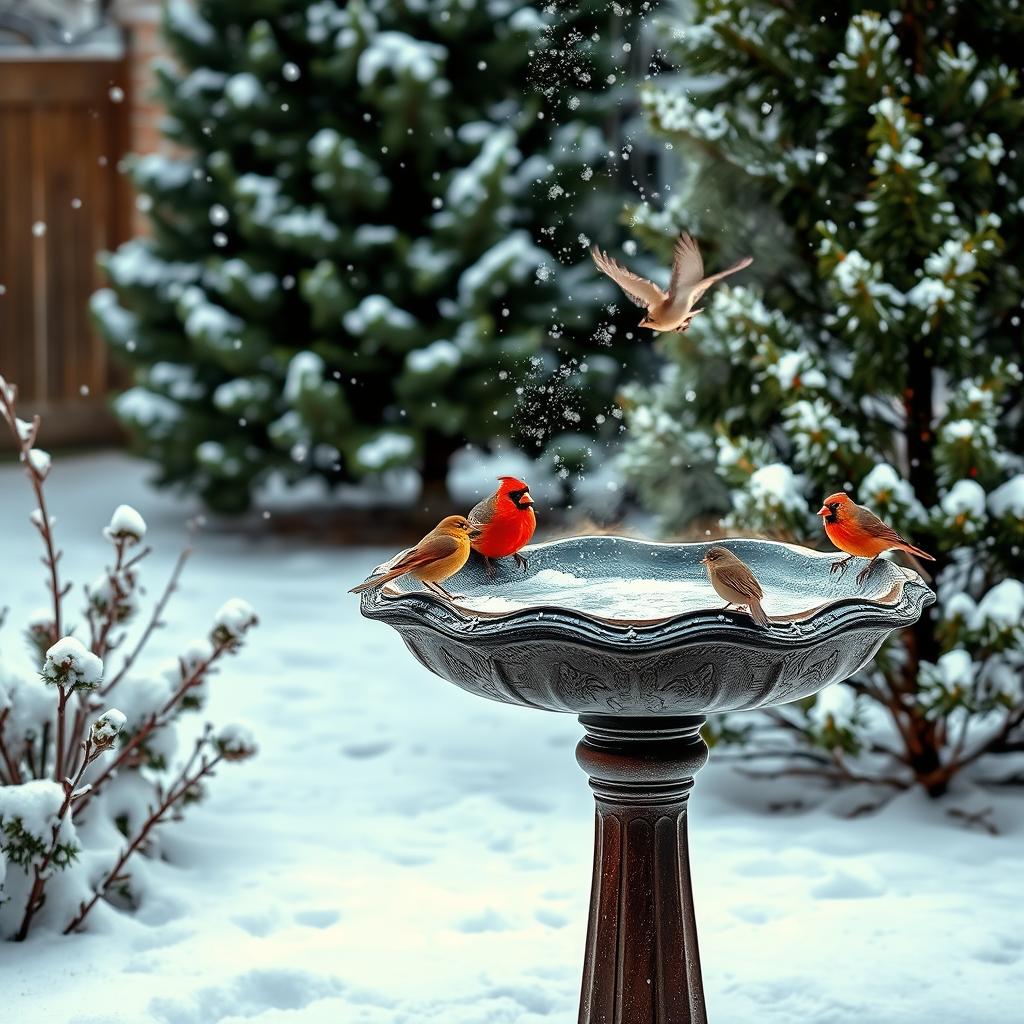
Experts say there are special ways to keep birds hydrated when it gets cold.
Heated Options for Cold Climates
- Thermostatically controlled bird bath heaters
- Built-in immersion heating elements
- Solar-powered heated bird bath models
- Plug-in bird bath warmers with temperature regulation
Preventing Ice Formation
There are smart ways to stop water from freezing in bird baths:
- Use floating ping pong balls to disrupt ice formation
- Place dark-colored stones in the bath to absorb sunlight
- Position bath in sunny areas to minimize freezing
Winter Maintenance Tips
| Maintenance Task | Frequency | Purpose |
|---|---|---|
| Clean bath thoroughly | Weekly | Prevent bacterial growth |
| Check electrical connections | Monthly | Ensure safe heating operation |
| Monitor water level | Daily | Maintain consistent water supply |
*”Providing water during winter can literally save bird lives.”* – Wildlife Conservation Expert
By using these heated bird baths, bird lovers can help their local bird friends. They can keep them hydrated even in the coldest times.
Natural and Eco-Friendly Bird Bath Designs

Building a garden bird bath that fits with nature does more than just give birds water. It turns your outdoor area into a safe haven for wildlife. Making your own bird bath can be both lovely and good for the planet.
“Nature always provides the best inspiration for wildlife-friendly spaces.” – Wildlife Conservation Expert
Green gardeners can make amazing bird baths from natural stuff that looks great in the garden. Here are some cool ideas:
- Repurpose large flat stones to create natural water collection areas
- Use reclaimed wood or ceramic pieces as bath foundations
- Incorporate native plants around the bird bath to create a complete ecosystem
- Select materials that withstand outdoor conditions without chemical treatments
When making your bird bath, pick materials that help local wildlife. Options like river rocks, clay, and untreated wood make great water spots for birds.
Adding native plants around your bird bath is a smart move. It makes the area safer for birds and looks great in your garden.
Important things to think about for natural bird baths include:
- Ensuring shallow water depths (1-2 inches)
- Providing textured surfaces for secure footing
- Selecting non-toxic, weather-resistant materials
- Maintaining consistent water cleanliness
Going for natural and eco-friendly bird bath designs helps local birds and makes your garden better for the environment.
Essential Maintenance and Cleaning Protocols
Keeping your bird bath clean is key to attracting and protecting local birds. Bird bath maintenance tips help create a healthy spot for birds. Regular cleaning stops harmful bacteria and keeps birds safe and healthy.
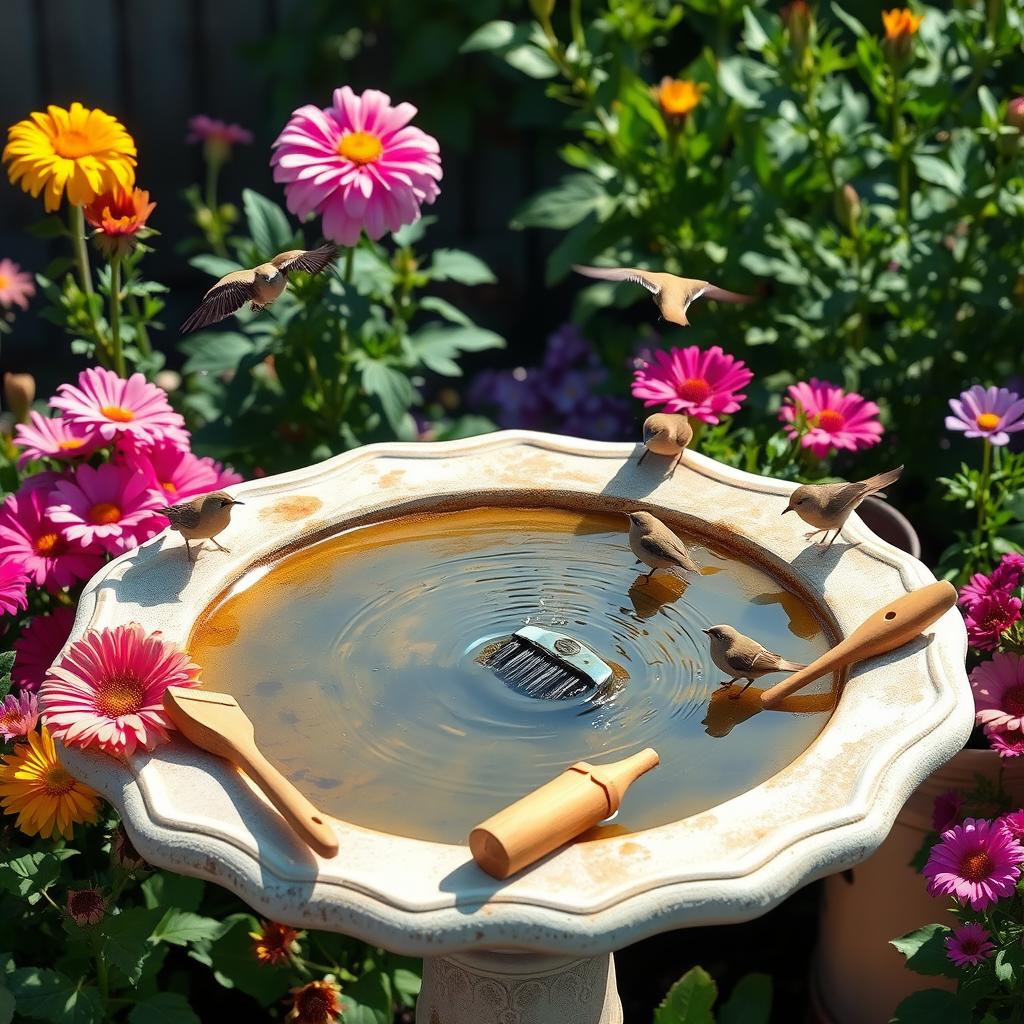
For a clean bird bath, you need a steady routine. Cleaning bird baths safely means more than just rinsing now and then.
Daily and Weekly Cleaning Routine
- Remove debris daily using a soft brush
- Dump and replace water every 2-3 days
- Scrub basin thoroughly once a week
- Rinse completely with clean water
Safe Cleaning Products for Birds
| Cleaning Solution | Bird Safety | Effectiveness |
|---|---|---|
| White Vinegar Solution | Very Safe | High |
| Hydrogen Peroxide (3%) | Safe | Moderate |
| Mild Dish Soap | Cautious Use | Effective |
Algae Prevention Techniques
Stopping algae growth is vital for bird bath care. Adding a few drops of apple cider vinegar can stop algae without harming birds. Place your bird bath in partial shade and clean often to cut down algae.
“A clean bird bath is a beacon of health for your backyard wildlife” – Wildlife Conservation Experts
By sticking to these bird bath care tips, you’ll make a welcoming, safe spot for birds. It will attract many bird species and keep them healthy.
Creative Landscaping Around Your Bird Bath
Turning your garden bird bath into a stunning centerpiece is all about landscaping. The right mix of plants, stones, and design can make your garden a haven for birds. It also boosts your outdoor look.
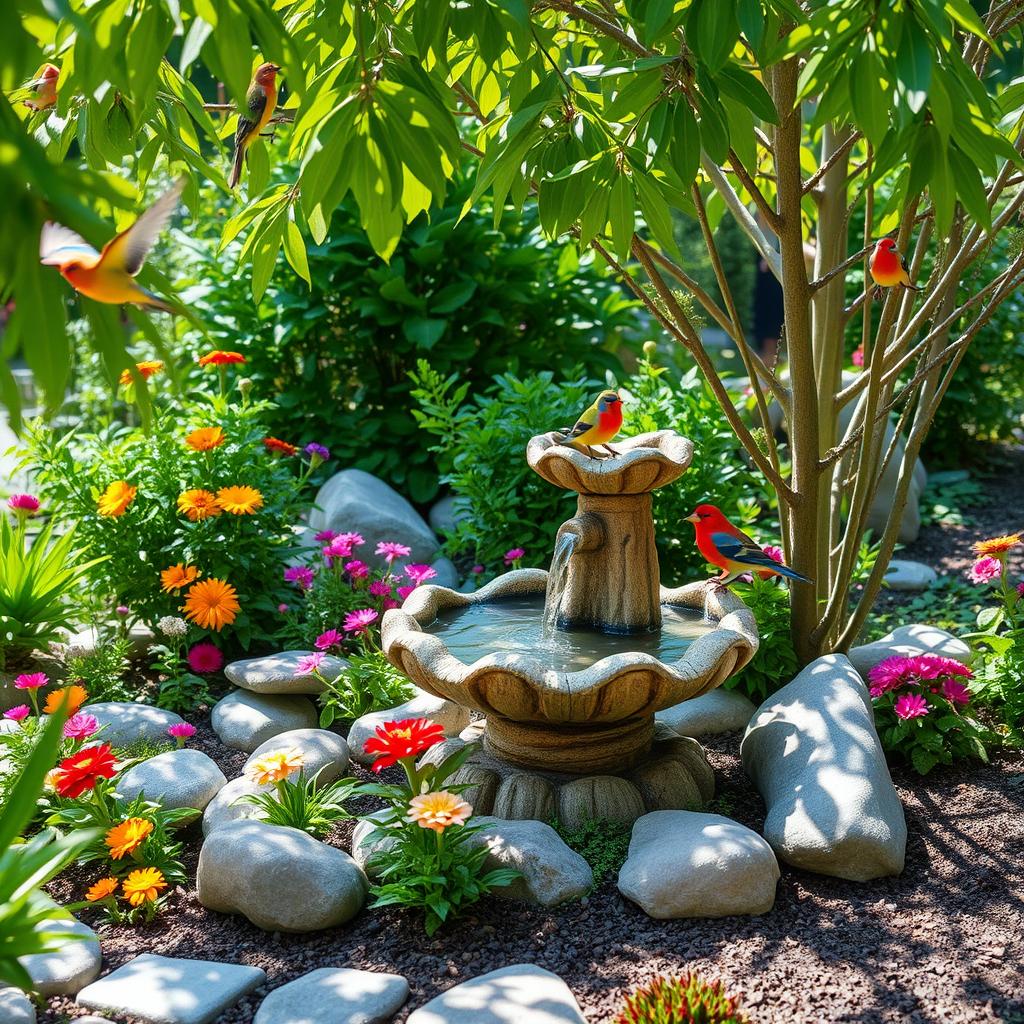
Designing unique bird bath styles means thinking about multi-level spaces. These spaces are both beautiful and useful. Native plants are key in supporting local bird life.
- Plant berry-producing shrubs near the bird bath
- Add native wildflowers for natural seed sources
- Create tiered landscaping with different heights
- Use decorative stones for visual interest
“A well-designed garden bird bath is more than just a water source—it’s a sanctuary for birds” – Wildlife Conservation Expert
Adding perches and protective plants can make your bird bath area safe and welcoming. Plants like elderberry, serviceberry, and native grasses offer great shelter and food.
| Plant Type | Bird Attraction Benefits | Maintenance Level |
|---|---|---|
| Elderberry | Berries, shelter | Low |
| Serviceberry | Fruit, nesting area | Low |
| Native Grasses | Seeds, ground cover | Very Low |
By adding these landscaping features, you’ll build a dynamic ecosystem. It supports local wildlife and makes your outdoor space more beautiful.
Troubleshooting Common Bird Bath Problems
Keeping a bird bath healthy needs quick action and care. Bird bath tips are key to a safe water spot for birds. Knowing common issues helps keep birds happy and wet.
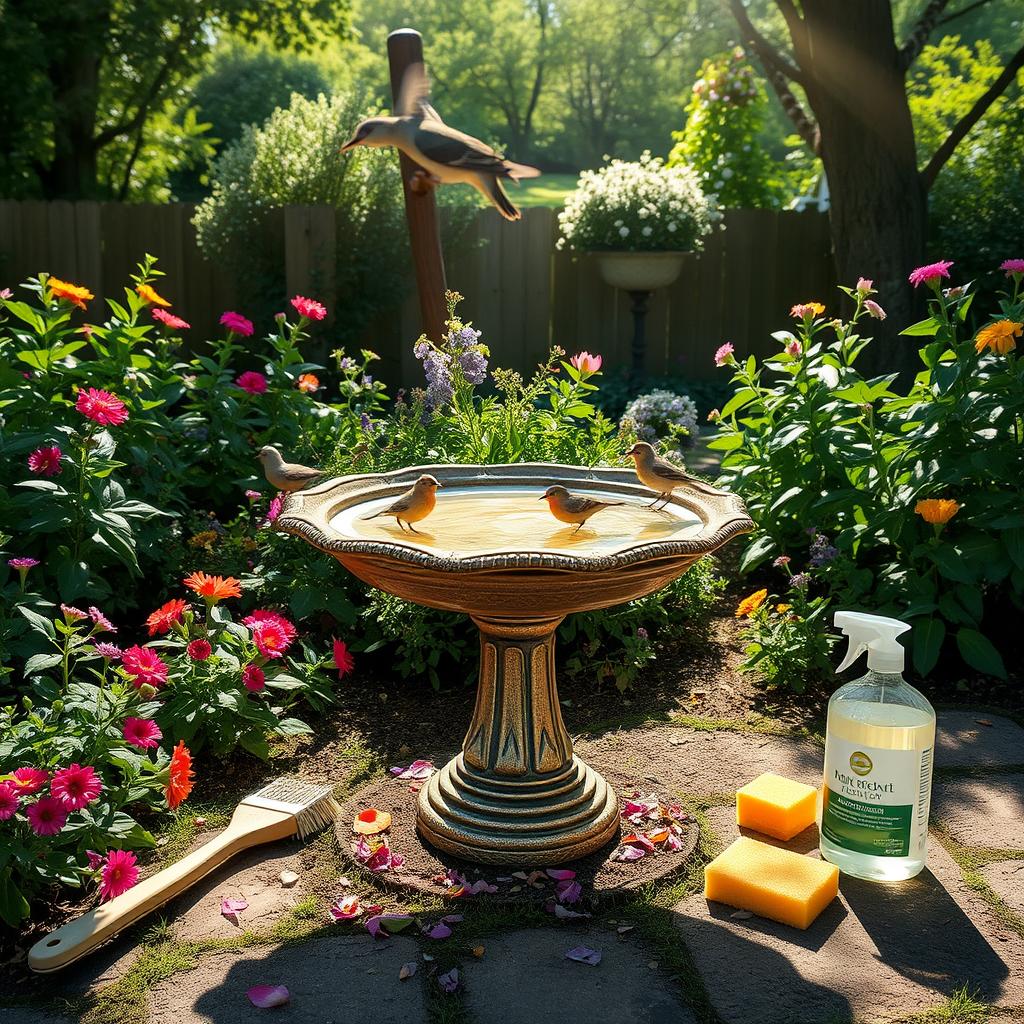
Water Level Management Strategies
Right water depth is vital for bird baths. Birds prefer shallow water for bathing and drinking. Here are important bird bath tips for water care:
- Check water levels daily during hot weather
- Use a small rock or pebble to help birds gauge water depth
- Refill water to maintain 1-2 inches of depth
- Install a drip system or mister for consistent water supply
Effective Pest Control Solutions
Stopping pests needs smart bird bath tips:
| Pest Type | Prevention Method | Effectiveness |
|---|---|---|
| Mosquitoes | Change water every 2-3 days | High |
| Algae | Use copper pennies or mild algaecide | Medium |
| Raccoons | Install motion-activated sprinklers | High |
Navigating Seasonal Challenges
Seasons change, so bird bath care must too:
- Summer: Add shade and increase water frequency
- Winter: Use heated bird bath or add warm water periodically
- Fall: Remove leaf debris regularly
- Spring: Deep clean and restart seasonal maintenance
“A well-maintained bird bath is a sanctuary for your backyard wildlife.” – Wildlife Conservation Expert
Regular care turns your bird bath into a lively spot for local birds.
Advanced Features for Your Bird Bath
Turning a simple bird bath into a wildlife magnet needs smart upgrades. The top bird baths attract birds with more than just water. They have cool designs that make a bird paradise.
Solar-powered bird bath fountains are a modern choice for lively water features. They offer many perks:
- Continuous water movement to prevent stagnation
- Attractive rippling effect that draws birds
- Energy-efficient operation using renewable solar power
- Minimal maintenance requirements
New tech can really boost your backyard bird spot. Think about these cool features:
| Feature | Bird Attraction Benefit |
|---|---|
| Multi-Tiered Design | Accommodates different bird species with varying water depth preferences |
| Built-In Misters | Simulates natural rain environments, attracting more diverse bird populations |
| Motion-Activated Sprayers | Keeps water fresh and creates dynamic movement |
Pro tip: Add perching stones and branches around your bird bath. It makes birds feel safe and comfy.
“The right bird bath is like a five-star resort for your feathered visitors” – Wildlife Photography Expert
Advanced bird bath features do more than just attract birds. They turn your backyard into a lively wildlife haven. From solar-powered fountains to multi-level designs, these smart solutions make bird baths into top wildlife spots.
Safety Considerations for Backyard Birds
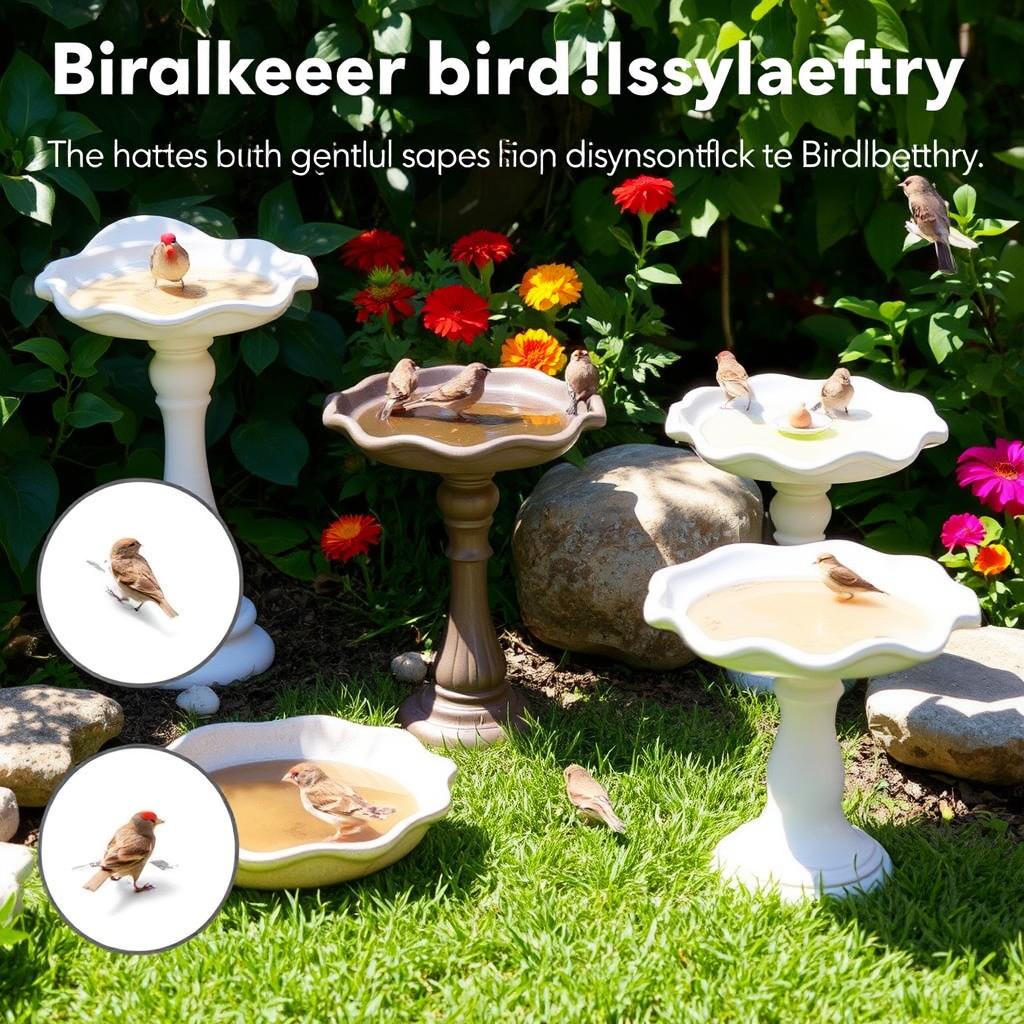
Creating safe bird baths is key for attracting birds. Bird lovers must think about the safety of their feathered friends. They need to know about risks and how to protect them.
Water depth is very important for bird safety. Shallow basins prevent accidental drowning and fit different bird species. Most birds like water that’s 1-2 inches deep, making it safe for them to bathe.
- Use textured surfaces to provide secure footing
- Avoid smooth, slippery materials
- Select non-toxic construction materials
- Position bird baths away from potential predator hiding spots
“A safe bird bath is the foundation of responsible wildlife attraction” – Backyard Birding Expert
Reflective surfaces near bird baths can confuse birds, leading to dangerous collisions. Place bird baths far from windows or use decals to protect them.
Cleaning bird baths regularly is crucial. Use bird-safe cleaners and rinse well to avoid harmful chemicals.
- Clean bird baths weekly
- Use mild, biodegradable soap
- Rinse completely with fresh water
- Replace water frequently
By following these safety tips, backyard bird lovers can make safe spaces for birds. These spaces will help protect and care for local bird populations.
Conclusion
Creating the perfect garden bird bath is more than a landscaping project. It’s an invitation to wildlife and a window into nature. Each element, from water depth to placement, helps create a backyard ecosystem birds will love.
Starting a bird bath doesn’t need expert skills or a big budget. Even a simple setup can turn your outdoor space into a vibrant sanctuary. Whether you go for a DIY design or a fancy solar-powered fountain, the key is regular maintenance and thinking about your local bird populations.
Your garden bird bath can become a daily discovery point. By offering a safe, clean water source, you attract birds and support local wildlife. The chirps, splashes, and interactions will bring you joy and remind you of nature’s simple pleasures.
As you start your bird bath journey, remember patience and observation are key. Begin small, learn from your experiences, and watch your backyard become a thriving habitat. This will connect you more deeply with the natural world around you.
FAQ
How deep should a bird bath be for different bird species?
The depth of a bird bath depends on the bird species. Most birds like water that’s 1-2 inches deep. Smaller birds like finches need only 1 inch, while larger birds like robins can handle up to 2-3 inches.
It’s important to include textured surfaces or stones. This provides secure footing and varied water levels.
What materials work best for a long-lasting bird bath?
Choose durable materials like concrete, ceramic, and powder-coated metal. Concrete is stable and keeps water temperature. Ceramic is attractive and easy to clean.
Metal baths with protective coatings resist rust and weathering. Avoid materials that crack easily or get too hot in sunlight.
How often should I clean my bird bath?
Clean your bird bath at least twice a week during active seasons. Remove standing water and scrub with a vinegar solution. Rinse well and refill with fresh water.
In hot summer months, clean it more often. This stops algae growth and mosquito breeding.
Can I create a bird bath on a budget?
Yes, you can! Make a bird bath from items like large ceramic plates or plant saucers. The key is a stable base, the right depth, and a textured surface.
Many effective bird baths can be made with little cost using items you might already have.
Where is the best place to position a bird bath?
Position your bird bath near shrubs or trees for quick escape routes. Keep it about 10 feet from feeders and natural cover. Aim for partial shade to prevent water from getting too hot.
Ensure the bath is visible but not exposed. Elevated positions offer extra safety for birds.
How can I prevent my bird bath from freezing in winter?
Use a heated bird bath or add a submersible heater. Float a ping pong ball or small plastic disc in the water to prevent freezing. Some gardeners use solar-powered heaters or heated bases.
Are solar-powered bird bath fountains worth installing?
Solar-powered fountains are great for attracting birds. They’re eco-friendly, don’t need wiring, and keep water fresh. The movement attracts more birds and prevents stagnation.
They work best in direct sunlight but may not perform as well on cloudy days.
What natural elements can I add around my bird bath to make it more attractive?
Add native plants like flowering shrubs and berry-producing bushes. These provide natural perches and food. Add flat stones for landing spots and create a small garden area.
This makes birds feel secure and comfortable.
How can I deter mosquitoes from breeding in my bird bath?
Change water often, at least every 2-3 days. Use mosquito dunks containing BTI to kill larvae. Keep the bath clean and add a small fountain or dripper.
This creates water movement that deters mosquito breeding.
What safety considerations are important when setting up a bird bath?
Make sure the bath is stable and has a rough surface for grip. Keep water shallow and provide multiple landing areas. Position it away from windows to prevent bird collisions.
Place it where cats or predators can’t access it. Regular cleaning and using non-toxic materials are key for bird health.
